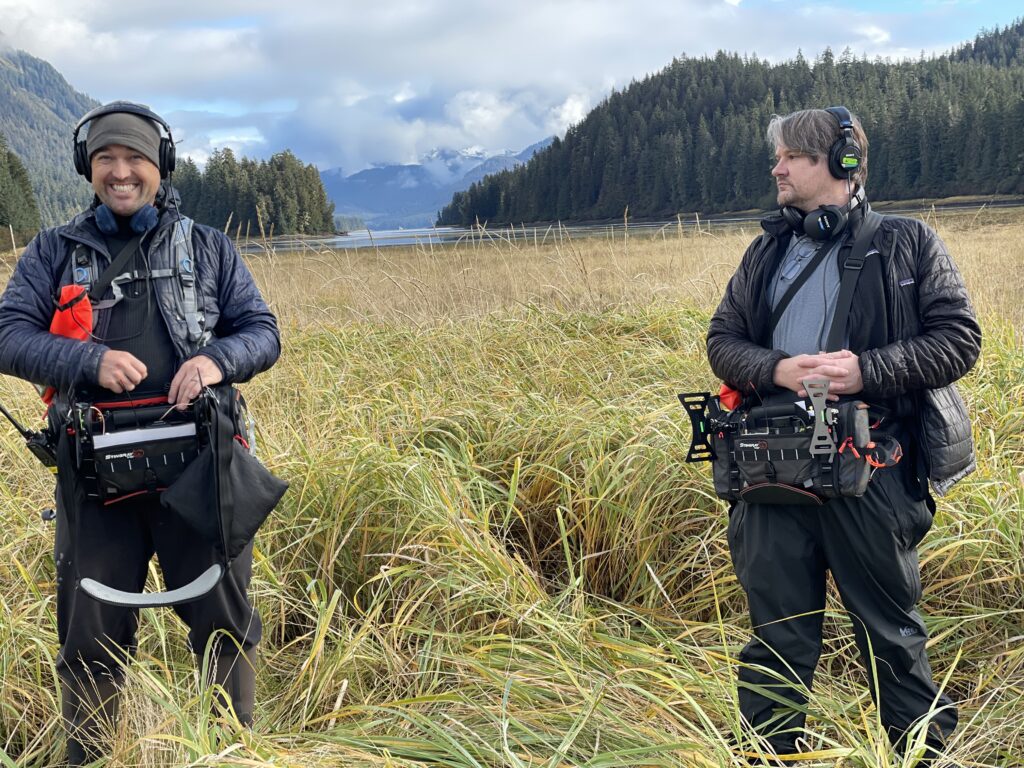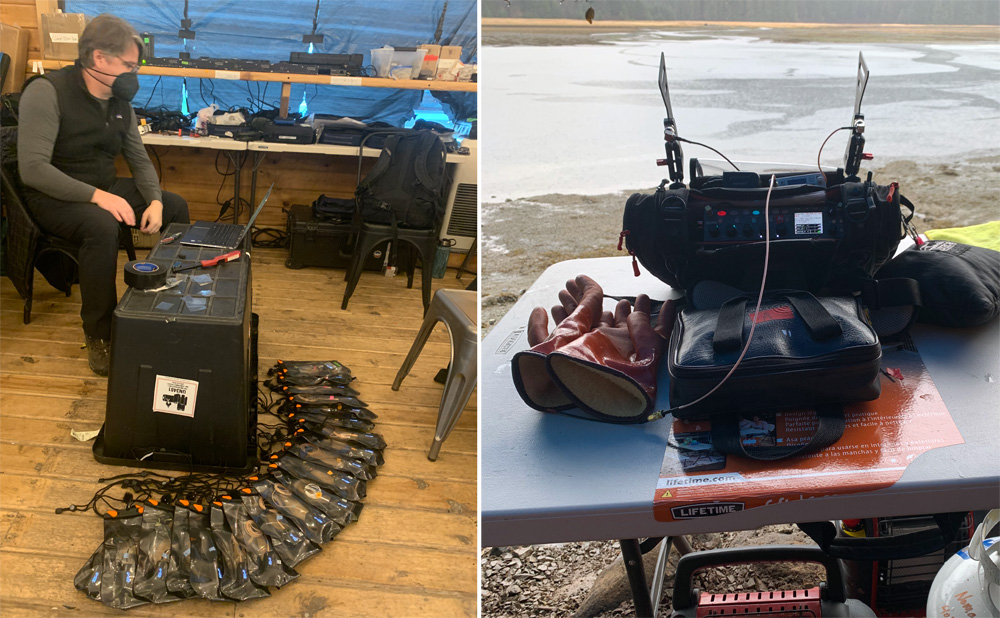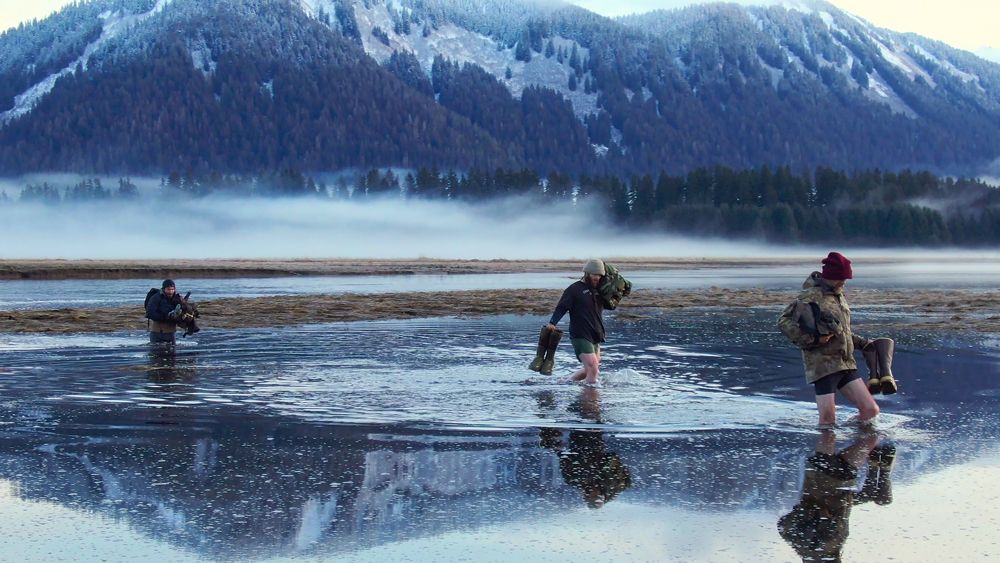
Surviving the Alaskan wilderness takes resourcefulness. For the production sound team of the raw competition series Outlast, now streaming on Netflix, it also required a specialized audio system that could record 16 contestants 24 hours a day during frigid temperatures, rain, sleet, and snow for a chance to win 1 million dollars. Audio supervisor Aaron Chandler along with sound mixers Joe Pfeil and Brandyn Johnson looked to Zaxcom technology in order to record flawless sound that could withstand the weather.
Hoonah, located 30 miles west of Juneau in Alaska’s panhandle, set the stage for the series that pins four teams against one another as they set up camp, search for food, and fight to survive. With each passing day, the remote location tests the limits of the contestants, and one by one, contestants start to drop out of the competition until two teams are left standing. Then the race for the prize money begins.
Joe Pfeil, who was born in Alaska, tells Zaxcom he felt in his element during production. First captivated by sound at a young age, Pfeil took a leap into the field following a tragic boating accident that almost pulled him underwater. “I almost died on that fishing boat. The moment I recovered, I wrote Full Sail University in Florida a hand letter to ultimately commit to my dreams.” The production sound mixer has been making waves since, working across different genres, recording ESPN’s 30 for 30, National Geographic’s Fish My City, Vice’s Hate Thy Neighbor, and the documentary Liberty: Mother of Exiles, which examines the history of Auguste Bartholdi’s Statue of Liberty.

To record Outlast, five Nova mixer/recorders, sixteen ZMT3-X bodypack transmitters, and several URX50 IFB audio receivers were deployed. The backbone of the involved audio system was the Nova where a single Nova was used as a master timecode generator which jammed timecode to the other four Novas in the field. Each team’s camp was outfitted with its own Nova and every contestant wore a ZMT3-X wireless transmitter. A fifth Nova was used on side missions throughout the series. Additionally, the Nova would broadcast timecode to the cameras filming the competition, which included two cameras per team, separate interview cameras, and mirrorless cameras. Production days could see upwards of 12 different cameras rolling.
“It was such a different job from documentary sound and feature film sound,” says Pfeil. “We had to record sound for 24 hours and give anybody and everybody complete access to the mixes on set of anyone they wanted to hear for storytelling purposes. We created such an excellent system that it worked flawlessly during the entire production.”
The shining light of the 24 hour record were the ZMT3-X bodypack transmitters. Part of Zaxcom’s Digital Recording Wireless, the ZMT3-X can simultaneously transmit audio while recording internally to a microSD memory card. The audio team relied on the internal recording functionality of the ZMT3-X to record audio while the transmitted audio sent to each Nova was treated as a backup recording. The ZMT3-X can run up to 16 hours on a single battery charge, but the audio team designated different periods during production to swap out the battery and memory card. Each bodypack was paired with a DPA 6061 lavalier for the mic’s ability to handle louder sound sources and inclement weather.

To mount the bodypack and lav combo, Aaron Chandler devised a custom mount durable enough for the rugged terrain. The DPA 6061 was placed in Bubblebee’s Lav Concealer and wrapped in Bubblebee fur. Two safety pins were used to mount the lav to the coat of the talent. “We were extremely careful about how we mounted them on the jackets,” notes Pfeil. “We did not want to poke too many holes in these jackets since these competitors would be working in the rain and snow. We found an almost permanent solution for mounting the lav.” The Zaxcom URX50 IFB was another key element to their workflow. The audio receiver allowed producers to tune directly into any of the camp’s audio mixes or to a contestant directly, allowing them to listen for on location interviews.
A point of contact for field operations was set up on a large boat docked in a nearby port. The location was also used to establish communications and for health and safety reasons for contestants and crew during the weeks long survival show. Additionally, each team had a bear guard to ensure safety while trying to survive outdoors. On shooting days, small skiffs transported crew down river to team camps. When the tide was too low, the crew would hike the trail on foot.

Contestants were pushed to the brink as it rained and snowed for days on end. Food became scarce. To ensure the audio gear and the sound team’s personal gear made it through the volatile weather, weak points were epoxied and taped. “After working on fishing boats for eight years, I can tell you that wet feet in cold temperatures is a no go,” says Pfeil. “It was hard to believe, but after all the rain we put those machines through, none of the Nova recorders, bodypack transmitters or IFBs were destroyed.”
In filming the climatic episode, which sees the final two teams race to the coast for a stash of cash, the ZMT3-X transmitters recorded audio onto the internal microSD memory cards while a GPS tracking system pinpointed the contestants’ location. When the teams reached a certain point in the trail, sound used skiff boats to track the contestants to the final destination. Antennas were deployed to transmit audio to the Nova mixer/recorders while contestants raced to the finish line.
Looking back Pfeil says, “For me it was fun. I have done work like this before, so I was comfortable enough and had good gear to record the sound thanks to Zaxcom.”
The Sound of Outlast – courtesy of Gotham Sound
Following our interview with Joel Pfeil, Gotham Sound explores the Outlast workflow further in the video below: